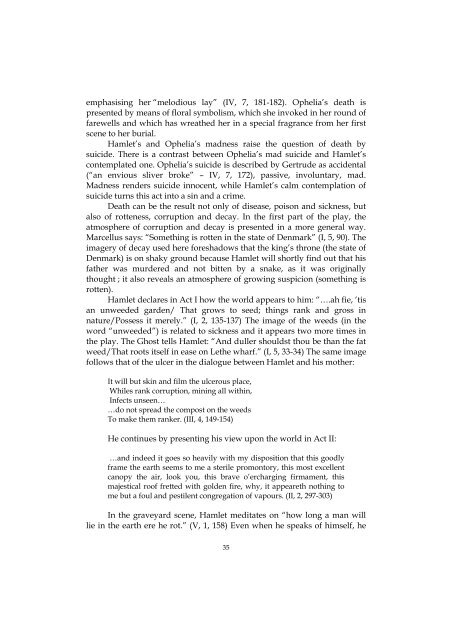translation studies. retrospective and prospective views
translation studies. retrospective and prospective views
translation studies. retrospective and prospective views
Create successful ePaper yourself
Turn your PDF publications into a flip-book with our unique Google optimized e-Paper software.
emphasising her “melodious lay” (IV, 7, 181-182). Ophelia’s death is<br />
presented by means of floral symbolism, which she invoked in her round of<br />
farewells <strong>and</strong> which has wreathed her in a special fragrance from her first<br />
scene to her burial.<br />
Hamlet’s <strong>and</strong> Ophelia’s madness raise the question of death by<br />
suicide. There is a contrast between Ophelia’s mad suicide <strong>and</strong> Hamlet’s<br />
contemplated one. Ophelia’s suicide is described by Gertrude as accidental<br />
(“an envious sliver broke” – IV, 7, 172), passive, involuntary, mad.<br />
Madness renders suicide innocent, while Hamlet’s calm contemplation of<br />
suicide turns this act into a sin <strong>and</strong> a crime.<br />
Death can be the result not only of disease, poison <strong>and</strong> sickness, but<br />
also of rotteness, corruption <strong>and</strong> decay. In the first part of the play, the<br />
atmosphere of corruption <strong>and</strong> decay is presented in a more general way.<br />
Marcellus says: “Something is rotten in the state of Denmark” (I, 5, 90). The<br />
imagery of decay used here foreshadows that the king’s throne (the state of<br />
Denmark) is on shaky ground because Hamlet will shortly find out that his<br />
father was murdered <strong>and</strong> not bitten by a snake, as it was originally<br />
thought ; it also reveals an atmosphere of growing suspicion (something is<br />
rotten).<br />
Hamlet declares in Act I how the world appears to him: “….ah fie, ‘tis<br />
an unweeded garden/ That grows to seed; things rank <strong>and</strong> gross in<br />
nature/Possess it merely.” (I, 2, 135-137) The image of the weeds (in the<br />
word “unweeded”) is related to sickness <strong>and</strong> it appears two more times in<br />
the play. The Ghost tells Hamlet: “And duller shouldst thou be than the fat<br />
weed/That roots itself in ease on Lethe wharf.” (I, 5, 33-34) The same image<br />
follows that of the ulcer in the dialogue between Hamlet <strong>and</strong> his mother:<br />
It will but skin <strong>and</strong> film the ulcerous place,<br />
Whiles rank corruption, mining all within,<br />
Infects unseen…<br />
…do not spread the compost on the weeds<br />
To make them ranker. (III, 4, 149-154)<br />
He continues by presenting his view upon the world in Act II:<br />
…<strong>and</strong> indeed it goes so heavily with my disposition that this goodly<br />
frame the earth seems to me a sterile promontory, this most excellent<br />
canopy the air, look you, this brave o’ercharging firmament, this<br />
majestical roof fretted with golden fire, why, it appeareth nothing to<br />
me but a foul <strong>and</strong> pestilent congregation of vapours. (II, 2, 297-303)<br />
In the graveyard scene, Hamlet meditates on “how long a man will<br />
lie in the earth ere he rot.” (V, 1, 158) Even when he speaks of himself, he<br />
35












